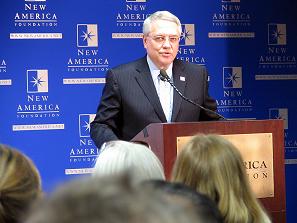Below, I just posted a piece by Richard Vague, a finance expert and businessman, on the subject of whether and when the U.S. government should bail out large firms. Now I am posting another guest post by colleague and international finance expert, Douglas Rediker, who serves as Co-Director of the New America Foundation Global Strategic Finance Initiative.
I asked Rediker to respond to the news that the dollar was on the skids and oil had shot up $25/barrel.
 Rediker responded:
Rediker responded:
I suspect that the markets are reacting not to the general idea of the bailout plan – which, after all was announced last week and was met with great applause by the market, but rather to the uncertainty of whether the plan will be enacted and how much political influence will creep into the final plan and implementation.
That leads to increased uncertainty, which, in turn leads to lower stock prices, higher interest rates and a lower dollar, which leads to higher commodity prices (priced in dollars). Yes, the plan will increase the US deficit, but that didn’t change between Friday and today.
What changed was the perception on Friday that Hank Paulson was firmly in charge and that he knew what he was doing. Today, the fear is that Paulson has to grapple with politicians and doesn’t have sweeping authority – that scares markets. Also, Paulson’s only got a few more months in office and no one knows who will replace him. That adds another layer to market uncertainty.
 Richard Vague just sent me this response to Rediker’s note:
Richard Vague just sent me this response to Rediker’s note:
What is also true is that a $700 billion buyout plan means $700 billion in “newly printed money” in circulation and thus a correspondingly weaker dollar. More dollars chasing the same amount of goods means that each dollar is worth less relative to commodities and other currencies.
Vague also referred me to a relatively tepid temperature-read of the economic situation from JPMorgan Chief Investment Officer Michael Cembalest’s “Eye on the Market” newsletter:
Martin Wolf at the Financial Times and editors at the Wall Street Journal apparently consider [this] the end of an era, writing things like “the day the dream of global free-market capitalism died”, and “10 days that changed capitalism”.
I disagree with them. This is how it has always worked. Sir Robert Peel, Britain’s Prime Minister in the 1840s, made it clear in the Bank of England’s charter debate: while it was important to set out rules of operation for financial markets that minimized moral hazard, it was equally important that the central bank suspend those rules to take action when necessary.
As only an Englishman could write, “while the charter is well-designed and while we are taking all precautions which legislation can prudently take against the recurrence of a monetary crisis, a crisis may occur in spite of our precautions. If it does, and if it be necessary to assume grave responsibility for the purpose of meeting it, I dare say men will be found willing to assume such responsibility”.
The Federal Reserve and the Treasury are acting the same way the Bank of England always did.
The events of the last week are bad for absolutists, since the U.S./U.K. model has always been about flexibility: a primary reliance on market mechanisms, but with a heavy dose of central planning and intervention in crisis. Not everything British was discarded in 1776; just the monarchy, and more fortuitously, the food.
But this not so sanguine context-setting comment came to me from businessman and Obama economic advisor Leo Hindery, who serves as Chair of the new Smart Globalization Initiative at the New America Foundation and is speaking at a forum we are organizing in the U.S. Senate tomorrow (Douglas Rediker and Richard Vague will both be there).
 Hindery offers (from a set of prepared remarks he is giving tomorrow):
Hindery offers (from a set of prepared remarks he is giving tomorrow):
As we all know, the Bush administration is asking Congress to let the government buy $700 billion in troubled mortgages, which would raise the statutory limit on the national debt to $11.3 trillion from $10.6 trillion. This $700 billion is over and above the $85 billion already committed to AIG, the $29 billion related to Bear Stearns, and the very conservative $25 billion associated with the bailouts of Fannie Mae and Freddie Mac.
The solutions being proposed are the most expensive combined bailout in the nation’s history and will sharply curtail the ability of the next president to push for tax cuts or new spending. And yet I believe they are not nearly enough, since they do not adequately cover the exposure associated with leveraged loans and, especially, the credit-default swaps market which has ballooned to a nearly unimaginable $45.5 trillion, from $900 billion in 2001.
This credit-default swaps market, which was developed by financiers who hired the best lobbyists they could to keep regulators away, is essentially nothing more than insurance on debt, but because there are now many more credit-default swaps outstanding than there are bonds for them to cover, it could potentially be a black hole of distress at least as large as the sub-prime mortgage crisis. Tens of trillions of dollars ago these swaps became nothing more than a way to gamble with almost no money down.
Alan Blinder suggested over the weekend that “the root cause of all of [our credit problems] is declining house prices”, and he is correct – but his observation ignores the fact that to this particular root ball were grafted a lot of other financial instruments which have together grown into one heck of a tree.
Senators Kent Conrad, Byron Dorgan and Richard Shelby of Alabama, and others, were more right than wrong when they said last week that more than likely “we’re talking about a trillion dollars.”
I think that we are talking more than a trillion, and I suspect Leo Hindery thinks the same.
This is a real indictment of the laissez-faire, manically neoliberal political economic order that we have had in place during the Clinton and Bush eras, and the excesses that the U.S. engaged in are staggering. But I don’t favor overthrowing everything — and I don’t favor a massive new over-regulated regime, but the combination of negligence as policy, turning a blind eye as policy, absence of regulation as policy — all combined a toxic ideology — has to be ended definitively.
As mentioned, tomorrow morning, I will be helping to chair a half day conference in the US Senate (Dirksen Senate Office Building, Room 124) on the current economic turmoil. I am not sure we will be able to Live Stream the meeting, but check back. If we can, we will. If not, it will be available later by video file and posted here.
This session which is sponsored by the New America Foundation Smart Globalization Initiative and Next Social Contract Initiative as well as the Economic Strategy Institute will feature former AT&T Broadband Networks CEO and Obama economic advisor LEO HINDERY, Congressman WALTER JONES (R-NC), former Senator ERNEST “FRITZ” HOLLINGS (D-SC), emerging markets experts and New America Foundation colleagues HEIDI CREBO-REDIKER and DOUGLAS REDIKER, National Journal columnist BRUCE STOKES, Washington Post columnist and American Prospect editor-at-large HAROLD MEYERSON, International Strategy and Investment Group Senior Managing Director and frequent Nightly Business Report guest TOM GALLAGHER, Federal Home Loan Finance Board Member ALLAN MENDELOWITZ, former IBM Director of Research and SVP for Science and Technology RALPH GOMORY, author and Manufacturing Policy Project Director PAT CHOATE, American Way of Strategy author and New America Foundation colleague MICHAEL LIND, New America Foundation Economic Growth Program Director Sherle Schwenninger, among others.
The session is open to the public if you would like to drop by.
More soon.
— Steve Clemons


9 comments on “Oil Surges $25/Barrel — A Discussion on the US Economy, its Stakeholders, and the Next Financial Era”